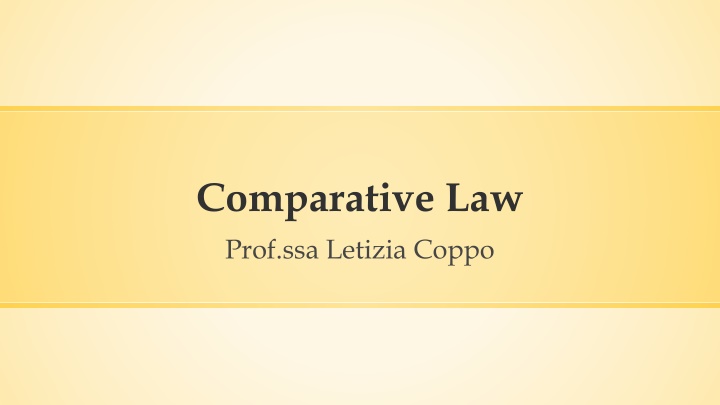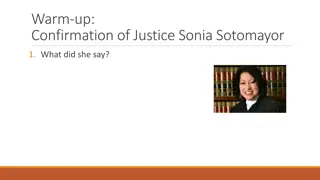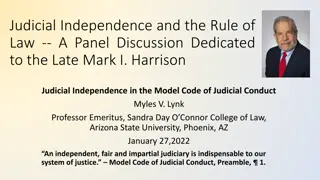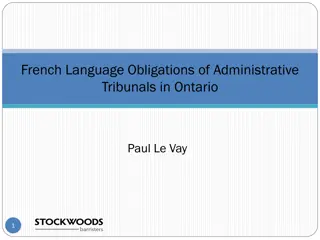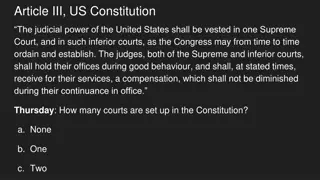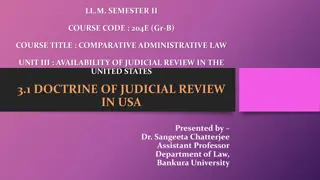Overview of the French Judicial System: Cour de Cassation
The French judicial system, including the Cour de Cassation, is independent of the executive and legislative powers. Cour de Cassation, established during the French Revolution, acts as a final arbitrator on legal disputes and ensures the proper interpretation of legislation. Lower courts can refer questions to it, and its decisions have significant legal implications. Napoleon's era saw changes in its role, making it a judge of the third instance.
Download Presentation

Please find below an Image/Link to download the presentation.
The content on the website is provided AS IS for your information and personal use only. It may not be sold, licensed, or shared on other websites without obtaining consent from the author.If you encounter any issues during the download, it is possible that the publisher has removed the file from their server.
You are allowed to download the files provided on this website for personal or commercial use, subject to the condition that they are used lawfully. All files are the property of their respective owners.
The content on the website is provided AS IS for your information and personal use only. It may not be sold, licensed, or shared on other websites without obtaining consent from the author.
E N D
Presentation Transcript
Comparative Law Prof.ssa Letizia Coppo
THE ROMANISTIC LEGAL FAMILY FRENCH LAW
THE FRENCH JUDICIAL SYSTEM (seeAnnexA) The judiciary is independent from the executive and the legislative powers. Several categories of courts divided into two major branches Judicial Branch: Civil courts: private disputes between individuals; do not impose penalties. Criminal courts: individuals who have committed offences. Administrative Branch: disputes between individuals and P.A.
THE FRENCH JUDICIAL SYSTEM (seeAnnexA) Cour de Cassation Established during the French Revolution under the name of Tribunal de Cassation. First function was to assist the legislature rather than to be a Court; its duty was to see that lower courts did not deviate from literal interpretation and thus undermine the supremacy of legislation.
THE FRENCH JUDICIAL SYSTEM (seeAnnexA) Cour de Cassation Lower courts were entitled to refer disputed questions of construction to the Cour de Cassation, as a representative of the legislative power (r f r facultatif). If the Court quashed the decision and the lower court did not comply with the holding, referral to the legislature was compulsory and the final decision binding (r f r obligatoire).
THE FRENCH JUDICIAL SYSTEM (seeAnnexA) Cour de Cassation The optional referral had hardly ever been used and with Napoleon the Court became a judge of third instance. The Court was (and is) only entitled to decide on the merits (sur le fond), not on the facts. But the distinction between merits and facts may be blurred.
THE FRENCH JUDICIAL SYSTEM (seeAnnexA) Cour de Cassation If the Court quashes a decision and the Appellate Court confirms it again, then the case is referred to the Joint Divisions. If the latter quash it again, the case is remitted to a third court, which is then bound to comply with the principles laid down by the Joint Divisions.
THE FRENCH JUDICIAL SYSTEM (seeAnnexA) Cour de Cassation In principle, any decision of a French court can be brought to the Court of Cass., provided that no other remedies are available or have been exhausted. If the requirements are met, then the Court must render a decision. No filter. The Court is overloaded like in Italy.
THE STYLE OF JUDGMENTS (seeAnnex B) The contents, structure and phraseology of the decisions issued by the Court of Cass. are characteristic of the particular style of French legal thinking. Every decision consists of one single sentence The Court dismisses , or The Court quashes and remits the matter to the Court of
THE STYLE OF JUDGMENTS (seeAnnex B) All the grounds of the decision are listed between the subject and the predicate of such sentence, in the form of a string of subordinate clauses all beginning with the same formula ( Attendu que , Whereas ). No particular section on the facts of the case or on the history of the procedure, except for what is strictly necessary to understand the Court s decision.
THE STYLE OF JUDGMENTS (seeAnnex B) Judges make every effort to keep the text of the decision as dense and compact as possible (4-5 pages). Subsidiary remarks, concurring and alternative rationes are just omitted. No digressions, no references to the background of the case or to legal history, legal policy or comparative law. No references to precedents or to scholarship; elegant style.
THE LEGAL PROFESSION IN FRANCE (seeAnnex C) Until the reforms of 1971 and 1990, there was a difference between two figures (+ conseiller juridique), with alternative functions. Avocat: oral pleading, presentation of facts and questions of law in the courtroom; member of the liberal profession; can negotiate its fees with the client. Avou : preparation of the case; proc dure, criture, postulation ; holder of a ministerial office; fixed salary.
THE LEGAL PROFESSION IN FRANCE (seeAnnex C) In 1971, unification of the legal profession under the headings nouvelle profession d avocat . In 1990 unification of avocats and conseillers juridiques. Yet, some differences between the two still exist, at least in the French mentality. Nowadays, trend towards the specialisation of lawyers and towards big law firms structured as LTD companies.
THE LAWYERING STYLE The representative lawyering style is the one of avocats: the character of the lawyer is immediately associated with pleadings in court. In France what is under the spotlight is the avocat, with its brilliant rhetoric and prestige; he is the representative of the French Bourgeoisie, coming out of the Revolution triumphal.
THE LAWYERING STYLE The ideal German lawyer is instead the learned doctor juris, the trained scholar. For him the struggle for rights takes place in books, in their firm; for the French lawyer it takes place in the courtroom and in Parliament. The Parliament has long been composed half of lawyers.
THE LAWYERING STYLE Close connection between lawyers and politics. At the beginning of the XIX century, French lawyers were building up the noble edifice of administrative law, especially through the jurisprudence of Conseil d tat, to protect the freedoms of citizens against the State intervention. Very theatrical style, clarity and brevity of expression, eloquence: la forme donne l tre la chose .
THE LAWYERING STYLE German lawyers, instead, were apolitical; their ideal qualities were thoroughness, exactitude, learnedness, strong tendency to tolerate academic disputes and ability to construe concepts of law in order to master the variety of legal reality. French lawyers use less technical vocabulary, while German lawyers language is highly specialised. After all, in France the legal education is part of the general education.
